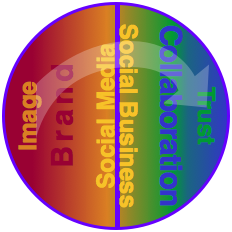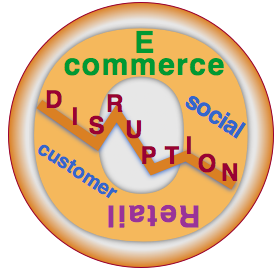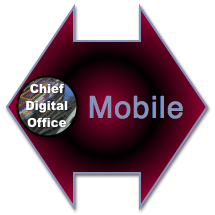Using Social Media and Social Business Together to Evolve Experience reveals differences between “the two socials,” and its startling conclusion is that most businesses will benefit from keeping them separate but related during the next three years.
 [Updated] There’s a much deeper context that makes the two socials vital: many of the assumptions on which business is built are being completely disrupted. For only one example, as Chief Marketer myself, I used to follow the mantra, “We always want to show our brand in the most positive light” (even when we’re lackluster). That impulse is increasingly risky. Take a few minutes and reflect on how profound that change is. Entire marketing and public relations industries are built on it, and it is very risky because people reveal the obfuscation and half-truths that used to work. There is no such thing as a “half” truth. [Updated] There’s a much deeper context that makes the two socials vital: many of the assumptions on which business is built are being completely disrupted. For only one example, as Chief Marketer myself, I used to follow the mantra, “We always want to show our brand in the most positive light” (even when we’re lackluster). That impulse is increasingly risky. Take a few minutes and reflect on how profound that change is. Entire marketing and public relations industries are built on it, and it is very risky because people reveal the obfuscation and half-truths that used to work. There is no such thing as a “half” truth.
From a practical standpoint, organizations need to manage their way through the transition to pervasive transparency, pacing their evolution with changing stakeholder expectations. This is where social media and social […]
How to Tap the Social Business Double Value Proposition outlines an efficient and rigorous process for using social business for digital transformation in two ways: social business itself can drive reputation, preference and profit, and it’s the fastest way to develop requirements for mobile, ecommerce and big data investments.
![How to Tap the Social Business Double Value Proposition [CDO Guide to Social Business Part2]](http://rollyson.net/wp-content/uploads/2013/06/CDO_socbus_2_main2.png)
The social business double value proposition works because it discovers, engages and validates the organization’s understanding of stakeholder outcomes. Every organization’s crucial stakeholders have outcomes that they hope to attain by interacting with the organization or using its products or services. Developing deep and broad knowledge of stakeholder outcomes enables the organization to serve and quickly deepen their relationships with their stakeholders—by helping them attain their outcomes by collaborating online; moreover, since it opens fast and inexpensive communication and collaboration channels with them, it can create a continuous innovation process and sustainable advantage over rivals.
The Guide to Social Business Part2 shows how to maximize efficiency by using external and internal analyses to create and execute social business strategy, […]
TheSocial Business Enabler of Digital Transformation reveals how social technologies have changed the economics of interacting and collaborating, and it presents four ways that Chief Digital Officers can use social to lower risk and boost returns of digital transformation.
![The Social Business Enabler of Digital Transformation [CDO Guide to Social Business Part1]](http://rollyson.net/wp-content/uploads/2013/06/CDO_socbus_1_main2.png) Social business competency is pivotal to digital transformation because it combines four unusual characteristics. First, it makes interacting and collaborating an order of magnitude faster and less costly than current processes; second, few organizations understand how to use social business to interact with key customers to boost profit, so leaders enjoy rare advantage; third, when compared to ecommerce, mobile and big data & analytics investments, social business shows results quickly and costs less. Lastly, social business reveals what stakeholders really think when organizations aren’t in the room, so it’s effective for due diligence and “requirements analysis” for ecommerce, mobile and big data investments. Social business competency is pivotal to digital transformation because it combines four unusual characteristics. First, it makes interacting and collaborating an order of magnitude faster and less costly than current processes; second, few organizations understand how to use social business to interact with key customers to boost profit, so leaders enjoy rare advantage; third, when compared to ecommerce, mobile and big data & analytics investments, social business shows results quickly and costs less. Lastly, social business reveals what stakeholders really think when organizations aren’t in the room, so it’s effective for due diligence and “requirements analysis” for ecommerce, mobile and big data investments.
As Social Business Enabler of Digital Transformation explains, social business has a two-fold value proposition for Chief Digital Officers: they can use social directly to drive reputation, innovation and […]
How Social Technologies Have Disrupted Organizations is a quick overview of the business and social environment around commercial, government and nonprofit organizations that sets the context for using social business for digital transformation.
![How Social Technologies Have Disrupted Organizations [CDO Guide to Social Business Preview]](http://rollyson.net/wp-content/uploads/2013/06/CDO_socbus_pre_main2.png) [UPDATED] Social technologies are quickly changing the context around why people buy products and services. Leaders of organizations in business, government and nonprofit sectors harbor a false assumption that is becoming lethal in the digital social age: they assume that products and services have inherent value to customers and constituents. In fact, products and services represent costs to customers and revenue to producers and service providers. [UPDATED] Social technologies are quickly changing the context around why people buy products and services. Leaders of organizations in business, government and nonprofit sectors harbor a false assumption that is becoming lethal in the digital social age: they assume that products and services have inherent value to customers and constituents. In fact, products and services represent costs to customers and revenue to producers and service providers.
Customers must use products or services to create outcomes that are personally or professionally meaningful. The use of the product or service is where the customer or constituent produces value. This is why they buy. “So what,” you might be thinking. In this post I’ll show how digital social technologies are weakening mediocre products and services and how organizations can use social business to strengthen their offerings. Read a more in-depth treatment in […]
 [UPDATED] The big omni-channel trap awaits digital executives who make huge technology, process and people investments to create new “experiences” for “connected customers” but neglect social technologies’ ability to engage people emotionally. Few business executives have spent enough quality time in digital social venues to appreciate how personally and deeply people collaborate online; rather, it is normal for CDOs, CMOs and CIOs to primarily think of “digital” as mechanizing technologies like Web transaction systems (ecommerce), mobile and big data. That’s the preconception baits the big omni-channel trap. The Big Omni-Channel Trap is second in CSRA’s retail & omni-channel series, and it will show you how to avoid the trap. [UPDATED] The big omni-channel trap awaits digital executives who make huge technology, process and people investments to create new “experiences” for “connected customers” but neglect social technologies’ ability to engage people emotionally. Few business executives have spent enough quality time in digital social venues to appreciate how personally and deeply people collaborate online; rather, it is normal for CDOs, CMOs and CIOs to primarily think of “digital” as mechanizing technologies like Web transaction systems (ecommerce), mobile and big data. That’s the preconception baits the big omni-channel trap. The Big Omni-Channel Trap is second in CSRA’s retail & omni-channel series, and it will show you how to avoid the trap.
More and more customers and other stakeholders are collaborating online and getting accustomed to being individually treated like people, not demographics of consumers or customers. They like it. People can’t resist places in which they, and others around them, are listened to and responded to meaningfully. People respond to each other’s emotions. Organizations that don’t appreciate this development will invest heavily and receive lackluster returns, weakening themselves at […]
Empowered customers and omni-channel commerce are mirrors of each other, and both are transforming “retail.”
 [UPDATED] Connected customers have the Internet in their pockets and use mobile and other devices in all stages of conceptualizing, considering, evaluating, buying and using purchased products and services. These customers want to interact with firms and brands in a seamless experience that features single sign-on as an entry point; they want the firm to respond using their individual data when that makes interacting more valuable. Omni-channel commerce refers to a collection of technologies, practices and strategies firms use to provide the personal individualized experience that connected customers expect. [UPDATED] Connected customers have the Internet in their pockets and use mobile and other devices in all stages of conceptualizing, considering, evaluating, buying and using purchased products and services. These customers want to interact with firms and brands in a seamless experience that features single sign-on as an entry point; they want the firm to respond using their individual data when that makes interacting more valuable. Omni-channel commerce refers to a collection of technologies, practices and strategies firms use to provide the personal individualized experience that connected customers expect.
IBM’s 2012 study of retail customers in eight mature economies (Australia, Canada, France, Italy, Japan, Spain, the UK and the USA) and seven growth economies (Argentina, Brazil, Chile, China, Colombia, Mexico and South Africa) lays bare that the retail “shopping” experience has shifted profoundly, although you wouldn’t know it by looking at most offline or online retailers’ presences. The paper, “Winning over the empowered consumer: Why trust matters,” is a call to […]
 How Mobile Transforms Relationships Between Brands and Customers presents underappreciated aspects of mobile user behavior before outlining three approaches for engaging customers and other stakeholders. How Mobile Transforms Relationships Between Brands and Customers presents underappreciated aspects of mobile user behavior before outlining three approaches for engaging customers and other stakeholders.
As outlined in Ubiquitous Computing Primer, “mobile” is much more than a channel or platform internet-connected devices. By any measure, the Internet’s information and utility are growing exponentially, and mobile devices put the Internet in people’s pockets, so they transform human capabilities and experience.
People plus the Internet have expanded abilities to act and perform. For example, having the optimal assortment of travel apps enables people to avoid many problems and capitalize on opportunities; they miss planes less often, pay less for hotels and suffer less crime. The same holds true for most human endeavors, so people without mobile internet are increasingly at disadvantage. [For more context, see: 1) the “Geoweb” and “Web 3.0.”
How Mobile Transforms Relationships Between Brands and Customers is Part2 of The CDO Guide to Mobile for Digital Transformation.
[…]
 Personal Individualized Experience is the DNA of digital transformation. It refers to using an optimal mix of people and digital technologies to provide personal interactions at scale, so it’s central to the mission of chief digital officers and CEOs and boards who hire them. Prior to digital and social technologies, organizations faced a trade-off between “personal” and “efficient” interactions with their stakeholders (customers, clients, employees, partners, regulators… hereafter “users”). Now this is no longer true; they can provide personal interactions at scale, once they learn how and where to interact efficiently and authentically. Personal Individualized Experience is the DNA of digital transformation. It refers to using an optimal mix of people and digital technologies to provide personal interactions at scale, so it’s central to the mission of chief digital officers and CEOs and boards who hire them. Prior to digital and social technologies, organizations faced a trade-off between “personal” and “efficient” interactions with their stakeholders (customers, clients, employees, partners, regulators… hereafter “users”). Now this is no longer true; they can provide personal interactions at scale, once they learn how and where to interact efficiently and authentically.
Used well, digital and social technologies retain an authentic human element while digitizing key aspects of relating to people. Therefore, organizations/firms/brands (hereafter “firms”) can now provide the Personal Individualized Experience (PIE). This post explains the three components of PIE and shows how firms can use them to build and maintain authentic and profitable relationships with users.
[…]
 Ubiquitous Computing Primer reveals mobile’s ultimate business context and enables astute digital executives to create a whole new layer of value from their mobile investments. “Mobile” is far more important than launching smartphone and tablet apps because “smart” devices will interact with each other to provide a new level of capability and customer experience. This primer is a very brief treatment of a complex subject, so follow its links to drill down. Ubiquitous Computing Primer reveals mobile’s ultimate business context and enables astute digital executives to create a whole new layer of value from their mobile investments. “Mobile” is far more important than launching smartphone and tablet apps because “smart” devices will interact with each other to provide a new level of capability and customer experience. This primer is a very brief treatment of a complex subject, so follow its links to drill down.
In 2013, smartphones and tablets imply that people are interacting with each other and “the Internet,” but “mobile” is becoming a “feature” of all kinds of devices and products in a phenomenon called “ubiquitous computing.”
Ubiquitous Computing Primer is Part1 of The CDO Guide to Mobile for Digital Transformation.
[…]
 U.S. healthcare transformation has been the subject of innumerable conferences, debates and programs for many years, and social business will play a large role. Reducing cost without sacrificing quality of care has become the common goal, so I believe social business will be a key lever because social technologies dramatically reduce the cost of collaboration. U.S. healthcare transformation has been the subject of innumerable conferences, debates and programs for many years, and social business will play a large role. Reducing cost without sacrificing quality of care has become the common goal, so I believe social business will be a key lever because social technologies dramatically reduce the cost of collaboration.
I have monitored healthcare reform for many years, and I sense that various factions, players and special interests are finally realizing that they must change. “Obamacare,” the protracted poor economy and a rapidly aging population are forcing many players out of their comfort zones.
I attended two events last week that provided interesting glimpses from behind the curtain, so I’ll share my notes here. One conference was co-sponsored by Baker & McKenzie and Deloitte, and the other was held at the University of Chicago Booth School of Business.
[…]
|
|
 [Updated] There’s a much deeper context that makes the two socials vital: many of the assumptions on which business is built are being completely disrupted. For only one example, as Chief Marketer myself, I used to follow the mantra, “We always want to show our brand in the most positive light” (even when we’re lackluster). That impulse is increasingly risky. Take a few minutes and reflect on how profound that change is. Entire marketing and public relations industries are built on it, and it is very risky because people reveal the obfuscation and half-truths that used to work. There is no such thing as a “half” truth.
[Updated] There’s a much deeper context that makes the two socials vital: many of the assumptions on which business is built are being completely disrupted. For only one example, as Chief Marketer myself, I used to follow the mantra, “We always want to show our brand in the most positive light” (even when we’re lackluster). That impulse is increasingly risky. Take a few minutes and reflect on how profound that change is. Entire marketing and public relations industries are built on it, and it is very risky because people reveal the obfuscation and half-truths that used to work. There is no such thing as a “half” truth.
![How to Tap the Social Business Double Value Proposition [CDO Guide to Social Business Part2]](http://rollyson.net/wp-content/uploads/2013/06/CDO_socbus_2_main2.png)
![The Social Business Enabler of Digital Transformation [CDO Guide to Social Business Part1]](http://rollyson.net/wp-content/uploads/2013/06/CDO_socbus_1_main2.png) Social business competency is pivotal to digital transformation because it combines four unusual characteristics. First, it makes interacting and collaborating an order of magnitude faster and less costly than current processes; second, few organizations understand how to use social business to interact with key customers to boost profit, so leaders enjoy rare advantage; third, when compared to ecommerce, mobile and big data & analytics investments, social business shows results quickly and costs less. Lastly, social business reveals what stakeholders really think when organizations aren’t in the room, so it’s effective for due diligence and “requirements analysis” for ecommerce, mobile and big data investments.
Social business competency is pivotal to digital transformation because it combines four unusual characteristics. First, it makes interacting and collaborating an order of magnitude faster and less costly than current processes; second, few organizations understand how to use social business to interact with key customers to boost profit, so leaders enjoy rare advantage; third, when compared to ecommerce, mobile and big data & analytics investments, social business shows results quickly and costs less. Lastly, social business reveals what stakeholders really think when organizations aren’t in the room, so it’s effective for due diligence and “requirements analysis” for ecommerce, mobile and big data investments.![How Social Technologies Have Disrupted Organizations [CDO Guide to Social Business Preview]](http://rollyson.net/wp-content/uploads/2013/06/CDO_socbus_pre_main2.png) [UPDATED] Social technologies are quickly changing the context around why people buy products and services. Leaders of organizations in business, government and nonprofit sectors harbor a false assumption that is becoming lethal in the digital social age: they assume that products and services have inherent value to customers and constituents. In fact, products and services represent costs to customers and revenue to producers and service providers.
[UPDATED] Social technologies are quickly changing the context around why people buy products and services. Leaders of organizations in business, government and nonprofit sectors harbor a false assumption that is becoming lethal in the digital social age: they assume that products and services have inherent value to customers and constituents. In fact, products and services represent costs to customers and revenue to producers and service providers. [UPDATED] The big omni-channel trap awaits digital executives who make huge technology, process and people investments to create new “experiences” for “connected customers” but neglect social technologies’ ability to engage people emotionally. Few business executives have spent enough quality time in digital social venues to appreciate how personally and deeply people collaborate online; rather, it is normal for CDOs, CMOs and CIOs to primarily think of “digital” as mechanizing technologies like Web transaction systems (ecommerce), mobile and big data. That’s the preconception baits the big omni-channel trap. The Big Omni-Channel Trap is second in CSRA’s retail & omni-channel series, and it will show you how to avoid the trap.
[UPDATED] The big omni-channel trap awaits digital executives who make huge technology, process and people investments to create new “experiences” for “connected customers” but neglect social technologies’ ability to engage people emotionally. Few business executives have spent enough quality time in digital social venues to appreciate how personally and deeply people collaborate online; rather, it is normal for CDOs, CMOs and CIOs to primarily think of “digital” as mechanizing technologies like Web transaction systems (ecommerce), mobile and big data. That’s the preconception baits the big omni-channel trap. The Big Omni-Channel Trap is second in CSRA’s retail & omni-channel series, and it will show you how to avoid the trap. [UPDATED] Connected customers have the Internet in their pockets and use mobile and other devices in all stages of conceptualizing, considering, evaluating, buying and using purchased products and services. These customers want to interact with firms and brands in a seamless experience that features single sign-on as an entry point; they want the firm to respond using their individual data when that makes interacting more valuable. Omni-channel commerce refers to a collection of technologies, practices and strategies firms use to provide the personal individualized experience that connected customers expect.
[UPDATED] Connected customers have the Internet in their pockets and use mobile and other devices in all stages of conceptualizing, considering, evaluating, buying and using purchased products and services. These customers want to interact with firms and brands in a seamless experience that features single sign-on as an entry point; they want the firm to respond using their individual data when that makes interacting more valuable. Omni-channel commerce refers to a collection of technologies, practices and strategies firms use to provide the personal individualized experience that connected customers expect. How Mobile Transforms Relationships Between Brands and Customers presents underappreciated aspects of mobile user behavior before outlining three approaches for engaging customers and other stakeholders.
How Mobile Transforms Relationships Between Brands and Customers presents underappreciated aspects of mobile user behavior before outlining three approaches for engaging customers and other stakeholders. Personal Individualized Experience is the DNA of digital transformation. It refers to using an optimal mix of people and digital technologies to provide personal interactions at scale, so it’s central to the mission of chief digital officers and CEOs and boards who hire them. Prior to digital and social technologies, organizations faced a trade-off between “personal” and “efficient” interactions with their stakeholders (customers, clients, employees, partners, regulators… hereafter “users”). Now this is no longer true; they can provide personal interactions at scale, once they learn how and where to interact efficiently and authentically.
Personal Individualized Experience is the DNA of digital transformation. It refers to using an optimal mix of people and digital technologies to provide personal interactions at scale, so it’s central to the mission of chief digital officers and CEOs and boards who hire them. Prior to digital and social technologies, organizations faced a trade-off between “personal” and “efficient” interactions with their stakeholders (customers, clients, employees, partners, regulators… hereafter “users”). Now this is no longer true; they can provide personal interactions at scale, once they learn how and where to interact efficiently and authentically. U.S. healthcare transformation has been the subject of innumerable conferences, debates and programs for many years, and social business will play a large role. Reducing cost without sacrificing quality of care has become the common goal, so I believe social business will be a key lever because social technologies dramatically reduce the cost of collaboration.
U.S. healthcare transformation has been the subject of innumerable conferences, debates and programs for many years, and social business will play a large role. Reducing cost without sacrificing quality of care has become the common goal, so I believe social business will be a key lever because social technologies dramatically reduce the cost of collaboration.